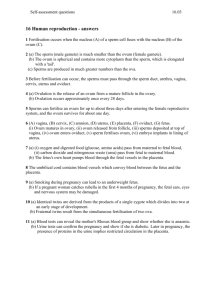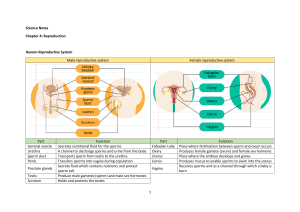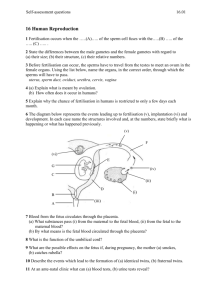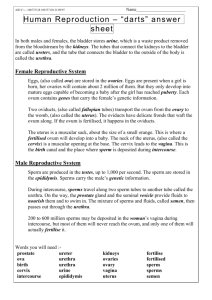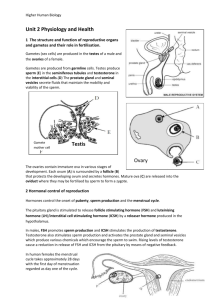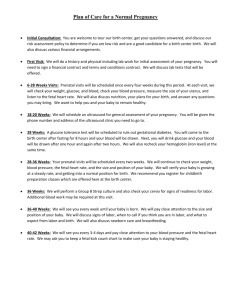Human reproduction
advertisement
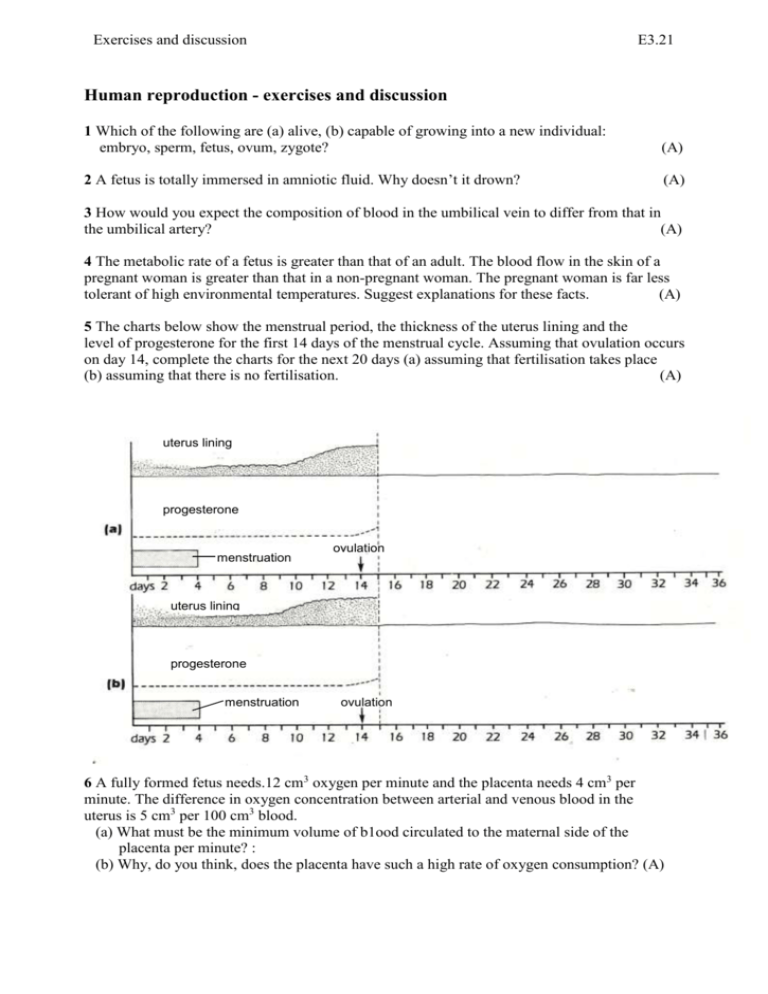
Exercises and discussion E3.21 Human reproduction - exercises and discussion 1 Which of the following are (a) alive, (b) capable of growing into a new individual: embryo, sperm, fetus, ovum, zygote? (A) 2 A fetus is totally immersed in amniotic fluid. Why doesn’t it drown? (A) 3 How would you expect the composition of blood in the umbilical vein to differ from that in the umbilical artery? (A) 4 The metabolic rate of a fetus is greater than that of an adult. The blood flow in the skin of a pregnant woman is greater than that in a non-pregnant woman. The pregnant woman is far less tolerant of high environmental temperatures. Suggest explanations for these facts. (A) 5 The charts below show the menstrual period, the thickness of the uterus lining and the level of progesterone for the first 14 days of the menstrual cycle. Assuming that ovulation occurs on day 14, complete the charts for the next 20 days (a) assuming that fertilisation takes place (b) assuming that there is no fertilisation. (A) uterus lining progesterone menstruation ovulation uterus lining progesterone menstruation ovulation 6 A fully formed fetus needs.12 cm3 oxygen per minute and the placenta needs 4 cm3 per minute. The difference in oxygen concentration between arterial and venous blood in the uterus is 5 cm3 per 100 cm3 blood. (a) What must be the minimum volume of b1ood circulated to the maternal side of the placenta per minute? : (b) Why, do you think, does the placenta have such a high rate of oxygen consumption? (A) Exercises and discussion E3.22 Human reproduction - exercises and discussion (continued) 7 The graph shows a woman's body temperature temperature as measured with a clinical ºC thermometer as soon as she wakes up each day. From other evidence it is assumed that ovulation occurred on day 16. (a) What was the range of daily temperature fluctuations before ovulation? (b) By how much did the temperature rise after ovulation? (c) In what ways does this temperature rise differ from the previous fluctuations? (d) Why could the daily temperature readings from day 1 to day 16 not be used to estimate fertile period (e) How could the temperature record be used to predict an infertile period (i.e. a menstrual period in which sexual intercourse would period be unlikely to result in a pregnancy). (I) 8 The chart shows the ages at which the changes associated with puberty take place in boys and girls. (a) What is the most common age at which boys undergo the changes of puberty? (b) If a girl had not started menstruation by the age of 15, would this be cause for concern? (c) Which two features of puberty show the greatest range in the times at which they occur. (d) Is it unusual for a girl of 9 years to start her menstrual periods? (e) On average, is it boys or girls who first show the onset of puberty? (I) days © Anna Flynn. breasts pubic hair height increase first menstrual period testes enlarge pubic hair height increase penis enlargement age © Passmore & Robson 9 Describe how you would design an investigation to find out whether the babies born to women who smoked during pregnancy had lower birth weights than babies born to non-smoking women. Discuss possible sources of error. (E) 10 When an ovum and sperms are observed under the microscope, it is seen that the sperms always swim towards the ovum. Which of the following is the best hypothesis to explain this observation? (a) It is necessary for the sperms to reach the ovum if fertilisation is to occur. (b) The sperms know instinctively where the ovum is. (c) The ovum produces chemicals which make the sperms swim towards it. (d) The sperms are attracted to the ovum by some means. (H) Exercises and discussion E3.23 Human reproduction - exercises and discussion (continued) E16.2 milk per day/ cm3 body weight/ kg 11 The graph shows the increase in weight of a breast-fed baby over the first 8 weeks. It also shows the weight of milk that the baby ingests. (a) Why, do you think, does the baby lose weight at first? (b) How long does it take for the baby to regain its birth weight? (c) What is the baby's approximate growth rate from day 5 (in grams per week)? (d) At this rate, approximately how long will it take for the baby to double its birth weight? (e) The weight of milk ingested is calculated by weighing the baby before and after the feed. Should the baby's nappy be changed before the second weighing? Explain your answer" (I) age/ days © Bell, Davidson and Emslie-Smith 12 Read the passage below, which is taken from an article ‘Glucose powers the fertilising sperm’. Glucose is the vital energy source which enables sperm to penetrate and fertilise ova, according to new results from Chelsea College in London. Lynn Fraser and Peter Quinn of Chelsea College in London discovered glucose's crucial role when they fertilised eggs extracted from mice - the results probably apply to humans as well. Lynn Fraser, who devised the experimental technique, has found that if the fertilising medium lacks glucose (normally present in the female tract), two important steps towards fertilisation fail to occur. Normally the sperm head loses its outer membrane releasing a store of enzymes that break down the egg’s outer layers. In the absence of glucose, the sperm falls to release the enzymes, so it cannot penetrate the egg. Secondly, there is no change in the way the sperms move in the early stages of their passage through the female reproductive tract towards the egg. After some hours - when they should be approaching the eggs - their tail waving becomes a very vigorous whiplash action. Fraser has now confirmed that this mechanical whiplashing enables sperm to penetrate the several layers of cells that surround the outer membrane. But without glucose they never begin to move this way - and so have an even smaller chance of fertilising the egg. Both the enzyme release and the change in motion occur almost immediately if glucose is placed in the medium © NEW SCIENTIST According to Fraser and Quinn's research (a) What two effects does glucose normally have on sperm cells? (b) What experimental evidence is there to support these suggestions? (c) How might the effects of glucose on sperm cells improve the chances of fertilisation? (d) Where does the glucose come from? (C)
